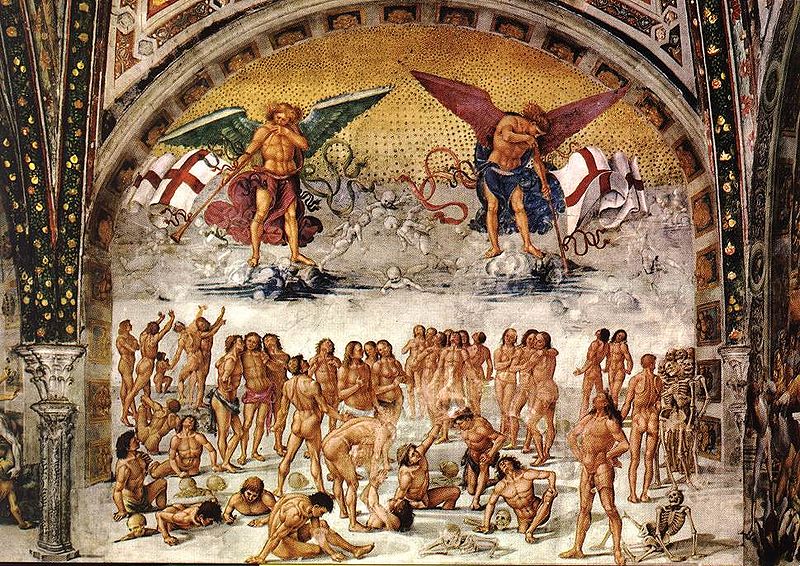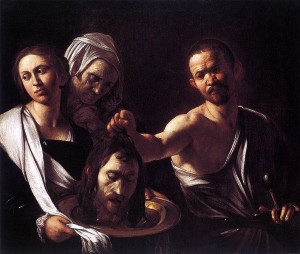
Luca Signorelli, “Resurrection of the Flesh” (1499-1502). Chapel of San Brizio, Duomo, Orvieto/Wikimedia Commons.
—————————
Labor Day’s gone. School’s on. Summer’s over. First day of fall. Just like that.
With renewed academic rigor now that classes are in session, we turn to more serious matters. We turn to Heaven above and seek the answers to the really big questions.
To do that, we’re resurrecting a conversation we had here on Art Scatter more than a year ago. And adding a little juice that’s been specially blessed.
The original post and comments were in July 2008. I wrote a comment but was too timid to post it. I stashed it away and let the great scroll of blog parchment roll up and pass me by.
But come the wee hours of Christmas eve/Christmas morn, Mr. Scatter and I were hangin’ in the living room sipping wine with family and the same topic came up. We started throwing around barbs and I fetched my laptop, called up the post, read through the comments and we laughed and laughed. And then I said, “You know, I have something I wrote that I never posted here.â€
 I called it up. And read it aloud. We laughed some more. And everyone urged me to post it as a comment. I still wasn’t sure, but the wine was flowing and the tree was sparkling and the company was cheery and did I mention the wine?
I called it up. And read it aloud. We laughed some more. And everyone urged me to post it as a comment. I still wasn’t sure, but the wine was flowing and the tree was sparkling and the company was cheery and did I mention the wine?
So I copied it into the comment field and clicked. It was comment No. 26. I told everyone that nobody would see it anyway except a pingback e-mail would go to the original poster: Barry Johnson. Remember him?
And then I realized it was Christmas, the comment was sorta about religion, and it was perfect timing. Merry Christmas, Barry.
The big question: If we raise our kids in a secular household and they grow up in public schools with no exposure to theology, how are they to understand the very basics and historic underpinnings of culture? Sure, we’re laughing here, but it’s a serious question. Please help us answer it.

William Blake, “The Temptation and Fall of Eve,” illustration to John Milton’s “Paradise Lost,” 1808. Wikimedia Commons.
——————————————–
A friend and I of similar theological anemic roots discovered that back in college we were in the same pathetic boat when it came to art history.
Friend: “OK, I get that it’s Jesus on the cross, but who’s that lady at his feet?â€
Me: “And the severed head that keeps appearing on all the platters? Who’s that?â€
So, with excerpts and mild editing, let the resurrection begin …
Barry: The book I’m most embarrassed that I haven’t read. Hmmm. Suddenly there are so many to choose from! Let’s see: Crime and Punishment. It is so big, it is so important, it is so daunting, and I know almost as much about it as books I’ve actually read and forgotten! But still… Hey, that feels better. Your confession below?
Mrs. Scatter: The Bible. Except for reading parts of a bad translation when I was a teen. I think I was trying to find out what all the fuss was about. Thankfully, it helped in that I was only slightly more than clueless come Western Civ class my freshman year of college. So how does someone brought up in a secular household and public schools begin to understand the very basics of all things Western thought? Architecture, paintings, music, philosophy? Literature? War AND peace? I worry about my boys in that the only bible story they know is from a hand-me-down book of David and Goliath, and really, what little boy wouldn’t like the story of the little guy who nails a giant with a rock between the eyes? What teen doesn’t want to do that to a parent? Come to think of it, I have read Oedipus Rex. But only seen a play version of Medea. God help me.
Mr. Scatter: I, on the other hand, have read a barrel full of Bible. Them’s great stories, and they really are crucial to understanding Western art and thought. Plus, there’s a big fun factor. When I was a kid my Baptist church had a dapper little preacher who sported a pencil mustache and played the saxophone. He was a hell of a performer — used to stand at the far side of the dais and start marching to the other side, yelling, “I’m going to Hell! I’m going to Hell! I’m going to Hell!†(I capitalize “Hell†because in these circles Hell was no metaphor; it was a real place.) Then, having reached the far end, he would “convert†himself by turning on his heel, marching back the other way, and shouting, “I’m going to Heaven! I’m going to Heaven! I’m going to Heaven!†Great stuff.
And remembering my teenage self, I can’t say enough about Wednesday night baptism ceremonies, which were full immersion and often featured young ladies dressed in nothing but loose white gowns. It was wet T-shirt contests before we’d ever heard of wet T-shirt contests, and my, did it bring out a keen sense of holiness in the horny young toads of the congregation. The Bible’s great for that sort of thing.
One day the saxophone-playing preacher hopped in a car with the honky-tonk church pianist, leaving his wife and kids behind, and headed off into the sunset, never to be seen in our town again. A few years later I read Elmer Gantry.
As I say, the Bible: Great stuff. And I mean that truly. Even beyond the sex.
Mrs. Scatter: For fear of laying bare our marriage under one dim, naked, energy-sucking lightbulb …. My religious upbringing basically consisted of my mom dropping me and my brother off at a local church and entrusting my brother to get me to the right Bible class. That lasted all of a couple of Sundays. The church had a creepy graveyard out back that could be seen from the school playground, and at recess my friends and I made up endless spooky stories about it and imagined things moving around among the headstones.
But lest you think I’m a total heathen … I remember visiting my aunt, and she “encouraged†me to go to church with her in such a way that it really wasn’t polite to refuse. When I asked my dad if I could go, he shrugged and said fine and then pulled out his wallet and handed me a dollar. Baffled, I secretly wondered, “Are there snack machines?†When I asked what the money was for, he said, “Offering plate,†and I thought, “Oh good, it really is a snack thing.â€
I don’t remember much about the sermons except they were long and boring and that I was going to hell if I wasn’t good. And, really, what parent wouldn’t want that branded on their kid? Repeatedly? And not just on Sundays?
Which makes me think it wouldn’t be so bad to drop off my own kids on a couple of Sundays. Free branding, after all. And free child care. What’s not to like? Well, the snacks come with a price. But, sure, I’d pony up a dollar for that.
So it seems that I have some reading to do. Crime and Punishment can wait. Or maybe it can’t. Honey, turn out the light and come help me with my Bible learnin’.
— Laura Grimes
————————————
Illustrations, from top:
Luca Signorelli, “Resurrection of the Flesh” (1499-1502). Chapel of San Brizio, Duomo, Orvieto/Wikimedia Commons.
“Salome With the Head of John the Baptist,” Caravaggio (157-1610), from Web Gallery of Art / Wikimedia Commons.
William Blake, “The Temptation and Fall of Eve,” illustration to John Milton’s “Paradise Lost,” 1808. Wikimedia Commons.
The historical integration of church and state in the pursuit of knowledge. Zürich, Wasserkirche: Former ‘Bürgerbibliothek’ (public library), as of 1719, by Johann Melchior Füssli/Wikimedia Commons.
Scary graveyards, or fount of knowledge? The Church of Saint Simeon Stylites in Aleppo, Syria, is considered to be one of the oldest surviving church buildings in the world. / Wikimedia Commons.